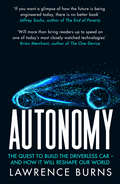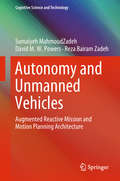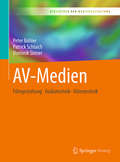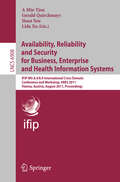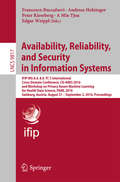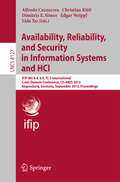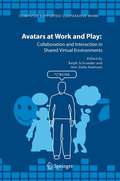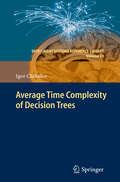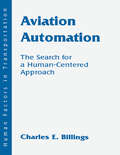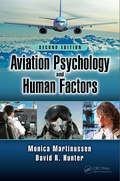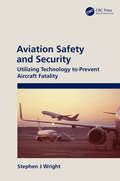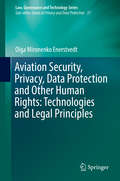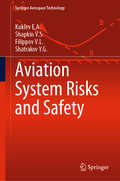- Table View
- List View
Autonomous Weapons Systems and the Responsibility of States: Challenges and Possibilities
by Lutiana Valadares Fernandes BarbosaThis book reviews whether the existing framework in place can effectively address breaches in the context of Autonomous Weapons Systems (AWS). The work endeavors to map out the main gaps and some possible approaches to address them. Part I sets the ground. First, it provides a concept of AWS. Next, it discusses the accountability gap AWS generate and shows how the international community has put far more emphasis on individual responsibility rather than state responsibility. Part II analyzes the challenges AWS pose to the regime governing state responsibility under international law, as codified in the Draft Articles on State Responsibility (ARSIWA). In this regard, it discusses attribution, breach of an international obligation, tempus comissi delicti, multiple states involved in a breach, force majeure, assurance of non-repetition, issues related to damage, the human-machine interaction and its impacts on state´s responsibility, responsibility for not using AWS, weapons review and the duty of due diligence. Part III summarizes the challenges discussed in part II in thirteen issues of concern and presents possible paths de lege ferenda to address each of those issues, mainly a paradigm shift in attribution and strict liability, among seven other more specific proposals. The conclusion reached is that the current regime on the international responsibility of states is insufficient to deal with the new challenges AWS pose. De lege ferenda, the book argues for following the paths suggested in part III. It also reflects on parts II and III's findings and how many of AWS's challenges to state´s responsibility apply to other autonomous devices. Therefore, through the case study of AWS, this work also opens the broader discussion of the gaps in the international responsibility of states regarding autonomous device misdoings.
The Autonomous Web (Studies in Big Data #101)
by Herwig Unger Mario KubekThis book initiates a transformation of the Web into a self-managing, autonomous information system to challenge today’s all-embracing role of big search engines as centralized information managers. In the last decades, the World Wide Web became the biggest source for all kinds of information needed. After a short review of the state of the art, a Web-based system is presented for the first time, which employs all its instances equally to provide, consume, and process information uniformly and consistently. In order to build such an efficient, decentralized, and fully integrated information space with all its needed functionalities, a set of diverse algorithms is introduced. These novel mechanisms for load balancing, routing, clustering, document classification, but also time-dependent information management pertain to almost all system levels. Finally, three different approaches to decentralized Web search are discussed that represent the backbone of the new autonomous Web.
Autonomy: The Quest To Build The Driverless Car - And How It Will Reshape Our World
by Lawrence Burns’A fascinating hybrid. Part freewheeling history of the rise of the modern autonomous vehicle, part intimate memoir from an insider who was on the front lines for much of that history, Autonomy will more than bring readers up to speed on one of today’s most closely watched technologies’ Brian Merchant, author of The One Device
Autonomy and Artificial Intelligence: A Threat or Savior?
by W. F. Lawless Ranjeev Mittu Donald Sofge Stephen RussellThis book explores how Artificial Intelligence (AI), by leading to an increase in the autonomy of machines and robots, is offering opportunities for an expanded but uncertain impact on society by humans, machines, and robots. To help readers better understand the relationships between AI, autonomy, humans and machines that will help society reduce human errors in the use of advanced technologies (e.g., airplanes, trains, cars), this edited volume presents a wide selection of the underlying theories, computational models, experimental methods, and field applications. While other literature deals with these topics individually, this book unifies the fields of autonomy and AI, framing them in the broader context of effective integration for human-autonomous machine and robotic systems. The contributions, written by world-class researchers and scientists, elaborate on key research topics at the heart of effective human-machine-robot-systems integration. These topics include, for example, computational support for intelligence analyses; the challenge of verifying today’s and future autonomous systems; comparisons between today’s machines and autism; implications of human information interaction on artificial intelligence and errors; systems that reason; the autonomy of machines, robots, buildings; and hybrid teams, where hybrid reflects arbitrary combinations of humans, machines and robots. The contributors span the field of autonomous systems research, ranging from industry and academia to government. Given the broad diversity of the research in this book, the editors strove to thoroughly examine the challenges and trends of systems that implement and exhibit AI; the social implications of present and future systems made autonomous with AI; systems with AI seeking to develop trusted relationships among humans, machines, and robots; and the effective human systems integration that must result for trust in these new systems and their applications to increase and to be sustained.
Autonomy and Unmanned Vehicles: Augmented Reactive Mission and Motion Planning Architecture (Cognitive Science and Technology)
by Somaiyeh MahmoudZadeh David M.W. Powers Reza Bairam ZadehThis book addresses higher–lower level decision autonomy for autonomous vehicles, and discusses the addition of a novel architecture to cover both levels. The proposed framework’s performance and stability are subsequently investigated by employing different meta-heuristic algorithms. The performance of the proposed architecture is shown to be largely independent of the algorithms employed; the use of diverse algorithms (subjected to the real-time performance of the algorithm) does not negatively affect the system’s real-time performance. By analyzing the simulation results, the book demonstrates that the proposed model provides perfect mission timing and task management, while also guaranteeing secure deployment. Although mainly intended as a research work, the book’s review chapters and the new approaches developed here are also suitable for use in courses for advanced undergraduate or graduate students.
Autonomy Oriented Computing: From Problem Solving to Complex Systems Modeling (Multiagent Systems, Artificial Societies, and Simulated Organizations #12)
by Jiming Liu XiaoLong Jin Kwok Ching TsuiAutonomy Oriented Computing is a comprehensive reference for scientists, engineers, and other professionals concerned with this promising development in computer science. It can also be used as a text in graduate/undergraduate programs in a broad range of computer-related disciplines, including Robotics and Automation, Amorphous Computing, Image Processing, Programming Paradigms, Computational Biology, etc. Part One describes the basic concepts and characteristics of an AOC system and enumerates the critical design and engineering issues faced in AOC system development. Part Two gives detailed analyses of methodologies and case studies to evaluate AOC used in problem solving and complex system modeling. The final chapter outlines possibilities for future research and development. Numerous illustrative examples, experimental case studies, and exercises at the end of each chapter of Autonomy Oriented Computing help particularize and consolidate the methodologies and theories presented.
Autonomy Requirements Engineering for Space Missions (NASA Monographs in Systems and Software Engineering)
by Emil Vassev Mike HincheyAdvanced space exploration is performed by unmanned missions with integrated autonomy in both flight and ground systems. Risk and feasibility are major factors supporting the use of unmanned craft and the use of automation and robotic technologies where possible. Autonomy in space helps to increase the amount of science data returned from missions, perform new science, and reduce mission costs.Elicitation and expression of autonomy requirements is one of the most significant challenges the autonomous spacecraft engineers need to overcome today. This book discusses the Autonomy Requirements Engineering (ARE) approach, intended to help software engineers properly elicit, express, verify, and validate autonomy requirements. Moreover, a comprehensive state-of-the-art of software engineering for aerospace is presented to outline the problems handled by ARE along with a proof-of-concept case study on the ESA's BepiColombo Mission demonstrating the ARE’s ability to handle autonomy requirements.
AV-Medien: Filmgestaltung – Audiotechnik – Videotechnik (Bibliothek der Mediengestaltung)
by Peter Bühler Patrick Schlaich Dominik SinnerDieser Band der „Bibliothek der Mediengestaltung“ behandelt die filmgestalterischen und technischen Grundlagen für AV-Produktionen für den Einsatz von Audio und Video in Digitalmedien.Für diese Bibliothek wurden die Themen des Kompendiums der Mediengestaltung neu strukturiert, vollständig überarbeitet und in ein handliches Format gebracht. Leitlinien waren hierbei die Anpassung an die Entwicklungen in der Werbe- und Medienbranche sowie die Berücksichtigung der aktuellen Rahmenpläne und Studienordnungen sowie Prüfungsanforderungen der Ausbildungs- und Studiengänge.Die Bände der „Bibliothek der Mediengestaltung“ enthalten zahlreiche praxisorientierte Aufgaben mit Musterlösungen und eignen sich als Lehr- und Arbeitsbücher an Schulen sowie Hochschulen und zum Selbststudium.
Availability, Reliability and Security for Business, Enterprise and Health Information Systems: IFIP WG 8.4/8.9 International Cross Domain Conference and Workshop, Vienna, Austria, August 22-26, 2011, Proceedings (Lecture Notes in Computer Science #6908)
by A. Min Tjoa Gerald Quirchmayr Ilsun You Lida XuThis book constitutes the refereed proceedings of the IFIP WG 8.4/8.9 International Cross Domain Conference and Workshop on Availability, Reliability and Security - Multidisciplinary Research and Practice for Business, Enterprise and Health Information Systems, ARGES 2011, held in Vienna, Austria, in August 2011.The 29 revised papers presented were carefully reviewed and selected for inclusion in the volume. The papers concentrate on the many aspects of availability, reliability and security for information systems as a discipline bridging the application fields and the well-defined computer science field. They are organized in three sections: multidisciplinary research and practice for business, enterprise and health information systems; massive information sharing and integration and electronic healthcare; and papers from the colocated International Workshop on Security and Cognitive Informatics for Homeland Defense.
Availability, Reliability, and Security in Information Systems: IFIP WG 8.4, 8.9, TC 5 International Cross-Domain Conference, CD-ARES 2016, and Workshop on Privacy Aware Machine Learning for Health Data Science, PAML 2016, Salzburg, Austria, August 31 - September 2, 2016, Proceedings (Lecture Notes in Computer Science #9817)
by Francesco Buccafurri Andreas Holzinger Peter Kieseberg A Min Tjoa Edgar WeipplThis volume constitutes the refereed proceedings of the IFIP WG 8.4, 8.9, TC 5 International Cross-Domain Conference on Availability, Reliability and Security in Information Systems, CD-ARES 2016, and the Workshop on Privacy Aware Machine Learning for Health Data Science, PAML 2016, co-located with the International Conference on Availability, Reliability and Security, ARES 2016, held in Salzburg, Austria, in September 2016. The 13 revised full papers and 4 short papers presented were carefully reviewed and selected from 23 submissions. They are organized in the following topical sections: Web and semantics; diagnosis, prediction and machine learning; security and privacy; visualization and risk management; and privacy aware machine learning for health data science.
Availability, Reliability, and Security in Information Systems: IFIP WG 8.4, 8.9, TC 5 International Cross-Domain Conference, CD-ARES 2014 and 4th InternationalWorkshop on Security and Cognitive Informatics for Homeland Defense, SeCIHD 2014, Fribourg, Switzerland, September 8-12, 2014. Proceedings (Lecture Notes in Computer Science #8708)
by Stephanie Teufel Tjoa A Min Illsun You Edgar WeipplThis volume constitutes the refereed proceedings of two workshops: the International Cross-Domain Conference and Workshop on Availability, Reliability and Security, CD-ARES 2014, and the 4th International Workshop on Security and Cognitive Informatics for Homeland Defense, SeCIHD 2014, co-located with the International Conference on Availability, Reliability and Security, ARES 2014, held in Fribourg, Switzerland, in September 2014. The 23 revised full papers presented were carefully reviewed and selected from numerous submissions. The papers deal with knowledge management, software security, mobile and social computing, enterprise information systems, homeland security and information processing.
Availability, Reliability, and Security in Information Systems and HCI: IFIP WG 8.4, 8.9, TC 5 International Cross-Domain Conference, CD-ARES 2013, Regensburg, Germany, September 2-6, 2013, Proceedings (Lecture Notes in Computer Science #8127)
by Alfredo Cuzzocrea Christian Kittl Dimitris E. Simos Edgar Weippl Lida XuThis book constitutes the refereed proceedings of the IFIP WG 8.4, 8.9, TC 5 International Cross-Domain Conference on Availability, Reliability and Security, CD-ARES 2013, held in Regensburg, Germany, in September 2013. The 21 revised papers presented were carefully reviewed and selected for inclusion in the volume. The papers concentrate on the many aspects of information systems bridging the gap between research results in computer science and the many application fields. They are organized in the following topical sections: economic, ethical, legal, multilingual, organizational and social aspects; context-oriented information integration; data/information management as a service; context-oriented information integration and location-aware computing; security and privacy; risk management and business continuity; and security and privacy and location based applications. Also included are 15 papers from a special session on Human-Computer Interaction and Knowledge Discovery (HCI-KDD 2013).
Avatare: Digitale Sprecher für Business und Marketing (X.media.press)
by Christian LindnerComputeroberflächen stehen vor einer technischen Revolution. "Avatare", intelligente Software-Programme, werden mit den Usern in natürlicher Sprache kommunizieren, sie auf der Suche nach Informationen und Produkten im Internet begleiten, sie beraten und ihnen alltägliche Aufgaben erleichtern. Obwohl in dieser Technologie erste Ansätze bereits verfügbar sind, werden deren Chancen für E-Business, Marketing und Werbung bisher kaum zur Kenntnis genommen. Eine Lücke, die dieses Buch durch einen interdisziplinären Ansatz zu verringern sucht. Wie ist der Entwicklungsstand natürlichsprachlicher Computersysteme? Wo liegen ihre Möglichkeiten und Grenzen? Wie können Unternehmen von diesen Trends profitieren? Dafür kommen neben Wissenschaftlern auch die im Markt bereits tätigen Unternehmen, Unternehmensberater und die Praktiker aus ausgewählten Projekten zu Wort.
Avatars at Work and Play: Collaboration and Interaction in Shared Virtual Environments (Computer Supported Cooperative Work #34)
by Ralph Schroeder Ann-Sofie AxelssonAvatars at Work and Play brings together contributions from leading social scientists and computer scientists who have conducted research on virtual environments used for collaboration and online gaming. They present a well-rounded and state-of-the-art overview of current applications of multi-user virtual environments, ranging from highly immersive virtual reality systems to internet-based virtual environments on personal computers. The volume is a follow-up to a previous essay collection, ‘The Social Life of Avatars’, which explored general issues in this field. This collection goes further, examining uses of shared virtual environments in practical settings such as scientific collaboration, distributed meetings, building models together, and others. It also covers online gaming in virtual environments, which has attracted hundreds of thousands of users and presents an opportunity for studying a myriad of social issues. Covering both ‘work’ and ‘play’, the volume brings together issues common to the two areas, including:What kind of avatar appearance is suitable for different kinds of interaction? How best to foster collaboration and promote usable shared virtual spaces? What kinds of activities work well in different types of virtual environments and systems?
Average Time Complexity of Decision Trees (Intelligent Systems Reference Library #21)
by Igor ChikalovDecision tree is a widely used form of representing algorithms and knowledge. Compact data models and fast algorithms require optimization of tree complexity. This book is a research monograph on average time complexity of decision trees. It generalizes several known results and considers a number of new problems. The book contains exact and approximate algorithms for decision tree optimization, and bounds on minimum average time complexity of decision trees. Methods of combinatorics, probability theory and complexity theory are used in the proofs as well as concepts from various branches of discrete mathematics and computer science. The considered applications includethe study of average depth of decision trees for Boolean functions from closed classes, the comparison of results of the performance of greedy heuristics for average depth minimization with optimal decision trees constructed by dynamic programming algorithm,and optimization of decision trees for the corner point recognition problem from computer vision. The book can be interesting for researchers working on time complexity of algorithms and specialists in test theory, rough set theory, logical analysis of data and machine learning.
Aviation Automation: The Search for A Human-centered Approach (Human Factors in Transportation)
by Charles E. BillingsThe advent of very compact, very powerful digital computers has made it possible to automate a great many processes that formerly required large, complex machinery. Digital computers have made possible revolutionary changes in industry, commerce, and transportation. This book, an expansion and revision of the author's earlier technical papers on this subject, describes the development of automation in aircraft and in the aviation system, its likely evolution in the future, and the effects that these technologies have had -- and will have -- on the human operators and managers of the system. It suggests concepts that may be able to enhance human-machine relationships in future systems. The author focuses on the ability of human operators to work cooperatively with the constellation of machines they command and control, because it is the interactions among these system elements that result in the system's success or failure, whether in aviation or elsewhere. Aviation automation has provided great social and technological benefits, but these benefits have not come without cost. In recent years, new problems in aircraft have emerged due to failures in the human-machine relationship. These incidents and accidents have motivated this inquiry into aviation automation. Similar problems in the air traffic management system are predicted as it becomes more fully automated. In particular, incidents and accidents have occurred which suggest that the principle problems with today's aviation automation are associated with its complexity, coupling, autonomy, and opacity. These problems are not unique to aviation; they exist in other highly dynamic domains as well. The author suggests that a different approach to automation -- called "human-centered automation" -- offers potential benefits for system performance by enabling a more cooperative human-machine relationship in the control and management of aircraft and air traffic.
Aviation Automation: The Search for A Human-centered Approach (Human Factors in Transportation)
by Charles E. BillingsThe advent of very compact, very powerful digital computers has made it possible to automate a great many processes that formerly required large, complex machinery. Digital computers have made possible revolutionary changes in industry, commerce, and transportation. This book, an expansion and revision of the author's earlier technical papers on this subject, describes the development of automation in aircraft and in the aviation system, its likely evolution in the future, and the effects that these technologies have had -- and will have -- on the human operators and managers of the system. It suggests concepts that may be able to enhance human-machine relationships in future systems. The author focuses on the ability of human operators to work cooperatively with the constellation of machines they command and control, because it is the interactions among these system elements that result in the system's success or failure, whether in aviation or elsewhere. Aviation automation has provided great social and technological benefits, but these benefits have not come without cost. In recent years, new problems in aircraft have emerged due to failures in the human-machine relationship. These incidents and accidents have motivated this inquiry into aviation automation. Similar problems in the air traffic management system are predicted as it becomes more fully automated. In particular, incidents and accidents have occurred which suggest that the principle problems with today's aviation automation are associated with its complexity, coupling, autonomy, and opacity. These problems are not unique to aviation; they exist in other highly dynamic domains as well. The author suggests that a different approach to automation -- called "human-centered automation" -- offers potential benefits for system performance by enabling a more cooperative human-machine relationship in the control and management of aircraft and air traffic.
Aviation Psychology and Human Factors
by Monica Martinussen David R. HunterThis book covers the application of psychological principles and techniques to situations and problems of aviation. It offers an overview of the role psychology plays in aviation, system design, selection and training of pilots, characteristics of pilots, safety, and passenger behavior. It covers concepts of psychological research and data analysis and shows how these tools are used in the development of new psychological knowledge. The new edition offers material on physiological effects on pilot performance, a new chapter on aviation physiology, more material on fatigue, safety culture, mental health and safety, as well as practical examples and exercises after each chapter.
Aviation Psychology and Human Factors
by Monica Martinussen David R. HunterThis book covers the application of psychological principles and techniques to situations and problems of aviation. It offers an overview of the role psychology plays in aviation, system design, selection and training of pilots, characteristics of pilots, safety, and passenger behavior. It covers concepts of psychological research and data analysis and shows how these tools are used in the development of new psychological knowledge. The new edition offers material on physiological effects on pilot performance, a new chapter on aviation physiology, more material on fatigue, safety culture, mental health and safety, as well as practical examples and exercises after each chapter.
Aviation Safety and Security: Utilizing Technology to Prevent Aircraft Fatality
by Stephen J WrightThis book focuses on ways to better manage and prevent aircraft-based homicide events while in flight using alternate technology to replace the Cockpit Voice Recorder (CVR) and/or Digital Flight Data Recorder (DFDR) functions. While these events are infrequent, the implementation of real-time predictive maintenance allows aircraft operators to better manage both scheduled and unscheduled maintenance events. Aviation Safety and Security: Utilizing Technology to Prevent Aircraft Fatality explores historical events of in-flight homicide and includes relevant accident case study excerpts from the National Transportation Safety Board (NTSB) and Air Accidents Investigation Branch (AAIB). FEATURES Explores historical events of in-flight homicide and offers solutions for ways to mitigate risk Explains how alternate technologies can be implemented to address in-flight safety issues Demonstrates that metrics for change are not solely for safety but also for financial savings for aircraft operation Includes relevant accident case study excerpts from the NTSB and AAIB Expresses the need for real-time predictive maintenance Stephen J Wright is an academic Professor at the faculty of Engineering and Natural Sciences at Tampere University, Finland, specializing in aviation, aeronautical engineering, and aircraft systems.
Aviation Safety and Security: Utilizing Technology to Prevent Aircraft Fatality
by Stephen J WrightThis book focuses on ways to better manage and prevent aircraft-based homicide events while in flight using alternate technology to replace the Cockpit Voice Recorder (CVR) and/or Digital Flight Data Recorder (DFDR) functions. While these events are infrequent, the implementation of real-time predictive maintenance allows aircraft operators to better manage both scheduled and unscheduled maintenance events. Aviation Safety and Security: Utilizing Technology to Prevent Aircraft Fatality explores historical events of in-flight homicide and includes relevant accident case study excerpts from the National Transportation Safety Board (NTSB) and Air Accidents Investigation Branch (AAIB). FEATURES Explores historical events of in-flight homicide and offers solutions for ways to mitigate risk Explains how alternate technologies can be implemented to address in-flight safety issues Demonstrates that metrics for change are not solely for safety but also for financial savings for aircraft operation Includes relevant accident case study excerpts from the NTSB and AAIB Expresses the need for real-time predictive maintenance Stephen J Wright is an academic Professor at the faculty of Engineering and Natural Sciences at Tampere University, Finland, specializing in aviation, aeronautical engineering, and aircraft systems.
Aviation Security, Privacy, Data Protection and Other Human Rights: Technologies and Legal Principles (Law, Governance and Technology Series #37)
by Olga Mironenko EnerstvedtThis book sheds light on aviation security, considering both technologies and legal principles. It considers the protection of individuals in particular their rights to privacy and data protection and raises aspects of international law, human rights and data security, among other relevant topics. Technologies and practices which arise in this volume include body scanners, camera surveillance, biometrics, profiling, behaviour analysis, and the transfer of air passenger personal data from airlines to state authorities.Readers are invited to explore questions such as: What right to privacy and data protection do air passengers have? How can air passenger rights be safeguarded, whilst also dealing appropriately with security threats at airports and in airplanes? Chapters explore these dilemmas and examine approaches to aviation security which may be transferred to other areas of transport or management of public spaces, thus making the issues dealt with here of paramount importance to privacy and human rights more broadly. The work presented here reveals current processes and tendencies in aviation security, such as globalization, harmonization of regulation, modernization of existing data privacy regulation, mechanisms of self-regulation, the growing use of Privacy by Design, and improving passenger experience. This book makes an important contribution to the debate on what can be considered proportionate security, taking into account concerns of privacy and related human rights including the right to health, freedom of movement, equal treatment and non-discrimination, freedom of thought, conscience and religion, and the rights of the child. It will be of interest to graduates and researchers in areas of human rights, international law, data security and related areas of law or information science and technology. I think it will also be of interest to other categories (please see e.g. what the reviewers have written)"I think that the book would be of great appeal for airports managing bodies, regulators, Civil Aviation Authorities, Data Protection Authorities, air carriers, any kind of security companies, European Commission Transport Directorate, European Air Safety Agency (EASA), security equipment producers, security agencies like the US TSA, university researchers and teachers.""Lawyers (aviation, privacy and IT lawyers), security experts, aviation experts (security managers of airports, managers and officers from ANSPs and National Aviation Authorities), decision makers, policy makers (EASA, EUROCONTROL, EU commission)"
Aviation System Risks and Safety (Springer Aerospace Technology)
by Kuklev E.A. Shapkin V.S. Filippov V.L. Shatrakov Y.G.This book provides a solution to “rare event” problems without using the classical theory of reliability and theory of probability. This solution is based on the methodology of risk assessment as “measure of danger” (in keeping with the ICS RAS) and an expert approach to determining systems’ safety indications using Fuzzy Sets methods. Further, the book puts forward a new concept: “Reliability, Risks, and Safety” (RRS). The book’s main goal is to generalize present results and underscore the need to develop an alternative approach to safety level assessment and risk management for technical (aviation) systems in terms of Fuzzy Sets objects, in addition to traditional probabilistic safety analysis (PSA). The concept it proposes incorporates ICAO recommendations regarding proactive system control and the system’s responses to various internal and external disturbances.
The Avid Handbook: Advanced Techniques, Strategies, and Survival Information for Avid Editing Systems
by Greg Staten Steve BayesBrimming with workflow efficiencies for the experienced editor, The Avid Handbook teaches you the hows and whys of operating the system in order to reach streamlined, creative end solutions. The book emphasizes time-saving techniques, shortcuts, and workflow procedures- the true keys to getting a job done.The book has also been updated to include new information on HD formats and workflows, color-correction and grading capability enhancements, MXF media standardization, and much more.Also new to this edition are an 8 page 4-color insert, adding depth to the color-correction lessons, as well as running sidebars throughout the book, calling out time-saving tips and techniques.
The Avid Handbook: Advanced Techniques, Strategies, and Survival Information for Avid Editing Systems
by Greg Staten Steve BayesBrimming with workflow efficiencies for the experienced editor, The Avid Handbook teaches you the hows and whys of operating the system in order to reach streamlined, creative end solutions. The book emphasizes time-saving techniques, shortcuts, and workflow procedures- the true keys to getting a job done.The book has also been updated to include new information on HD formats and workflows, color-correction and grading capability enhancements, MXF media standardization, and much more.Also new to this edition are an 8 page 4-color insert, adding depth to the color-correction lessons, as well as running sidebars throughout the book, calling out time-saving tips and techniques.


